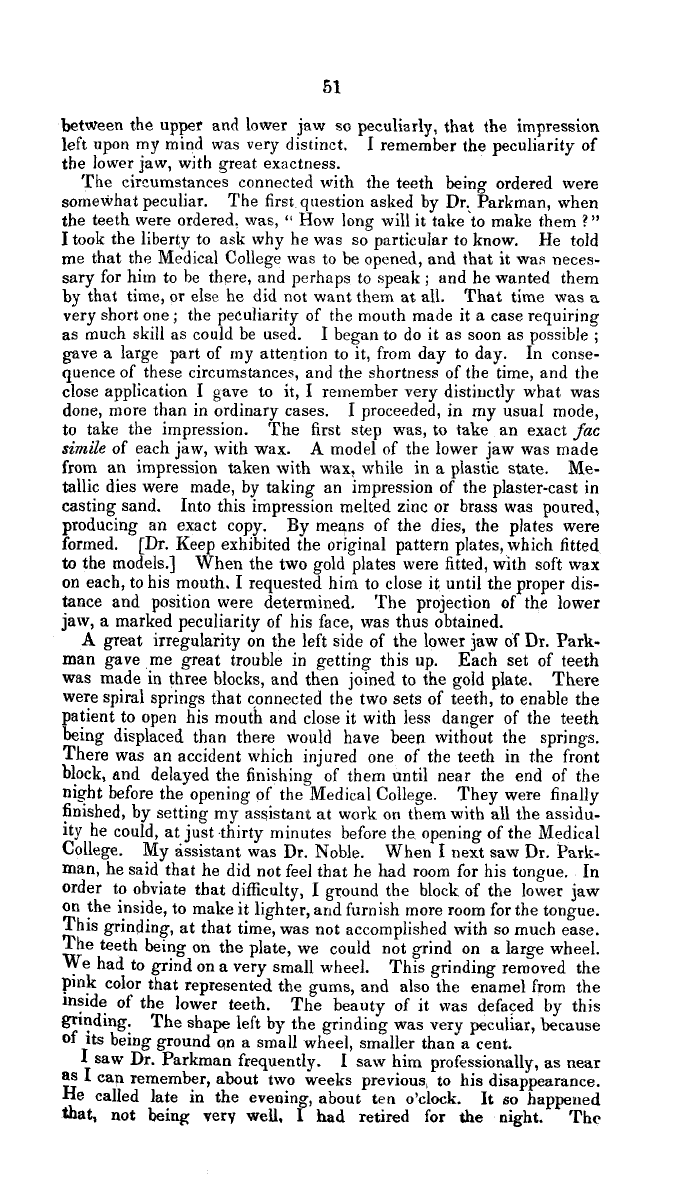|
51
between the upper and lower jaw so peculiarly, that the impression
left upon my mind was very distinct. I remember the peculiarity of
the lower jaw, with great exactness.
The circumstances connected with the teeth being ordered were
somewhat peculiar. The first-question asked by Dr. Parkman, when
the teeth were ordered, was, " How long will it take to make them ?"
I took the liberty to ask why he was so particular to know. He told
me that the Medical College was to be opened, and that it was neces-
sary for him to be there, and perhaps to speak; and he wanted them
by that time, or else he did not want them at all. That time was a
very short one; the peculiarity of the mouth made it a case requiring
as much skill as could be used. I began to do it as soon as possible ;
gave a large part of my attention to it, from day to day. In conse-
quence of these circumstances, and the shortness of the time, and the
close application I gave to it, I remember very distinctly what, was
done, more than in ordinary cases. I proceeded, in my usual mode,
to take the impression. The first step was, to take an exact fac
simile of each jaw, with wax. A model of the lower jaw was made
from an impression taken with wax, while in a plastic state. Me-
tallic dies were made, by taking an impression of the plaster-cast in
casting sand. Into this impression melted zinc or brass was poured,
producing an exact copy. By means of the dies, the plates were
formed. [Dr. Keep exhibited the original pattern plates, which fitted
to the models.] When the two gold plates were fitted, with soft wax
on each, to his mouth, I requested him to close it until the proper dis-
tance and position were determined. The projection of the lower
jaw, a marked peculiarity of his face, was thus obtained.
A great irregularity on the left side of the lower jaw of Dr. Park-
man gave me great trouble in getting this up. Each set of teeth
was made in three blocks, and then joined to the gold plate. There
were spiral springs that connected the two sets of teeth, to enable the
patient to open his mouth and close it with less danger of the teeth
being displaced than there would have beers without the springs.
There was an accident which injured one of the teeth in the front
block, and delayed the finishing of them until near the end of the
night before the opening of the Medical College. They were finally
finished, by setting my assistant at work on them with all the assidu-
ity he could, at just thirty minutes before the, opening of the Medical
College. My assistant was Dr. Noble. When I next saw Dr. Park-
man, he said that he did not feel that he had room for his tongue. In
order to obviate that difficulty, I ground the block of the lower jaw
on the inside, to make it lighter, and furnish more room for the tongue.
This grinding, at that time, was not accomplished with so much ease.
The teeth being on the plate, we could not grind on a large wheel.
We had to grind on a very small wheel. This grinding removed the
pink color that represented the gums, and also the enamel from the
inside of the lower teeth. The beauty of it was defaced by this
grinding. The shape left by the grinding was very peculiar, because
of its being ground on a small wheel, smaller than a cent.
I saw Dr. Parkman frequently. I saw him professionally, as near
as I can remember, about two weeks previous, to his disappearance.
He called late in the evening, about ten o'clock. It so happened
that, not being very well, I had retired for the night. The
|

